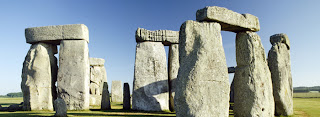Stonehenge: impermanent, imperfect, & impersonal.
According to the 2001 British national census, I'm an apparently rare breed - a British Buddhist. (There were 151,816 British Buddhists at that time resident in the UK. That's 0.3% of the total population.) My hometown is a small city in the English county of Wiltshire called Salisbury, also known historically as Sarum. So, as I live in Thailand these days, you could say that I’m a 'Sarumese' guy living amongst the Siamese. A more traditional moniker for someone who was born in Wiltshire is a 'Moonraker,' derived from a quaint story about smugglers who hid contraband alcohol in a river. When they returned at night and raked the water to retrieve their booty, they were confronted by some men of the law. To explain away their odd behavior, the smugglers said that they were raking the moon from the river, as its image was reflected in the water! I’ve never ascertained as to whether this bizarre excuse worked or not – I guess that’s not the point, really.
Not many people know the above tale, but one thing pertaining to Wiltshire that is known around the world is the giant megalithic structure called Stonehenge, that lies at the heart of the shire. As a 'Moonraker,' the Stones, as Stonehenge is also known, are a powerful symbol of where I come from, situated a few miles north of Salisbury. But, although a Buddhist rather than a Druid, I’m led to consider what they actually mean to me, if anything.
Contemplating the structure of Stonehenge leads me to think on the three characteristics (of existence), or tilakkhana, if you wanna be fancy. These are that all things are impermanent (anicca), imperfect (dukkha), and impersonal (anatta). The Stones are very, very old – over four thousand years old. No doubt they have aged dramatically during that time, and do not look exactly as they did when first erected. They typify all that is impermanent, despite their great age.
Stonehenge is by no means perfect, either. The original pattern in which the megaliths were placed has been disrupted, with some of the rocks broken and lying at odd angles to one another on the ground. They are subject to dukkha, to being imperfect; if they were perfect, they would still be in the same positions as they were four millennia ago, but of course they’re not. As with everything, they are vulnerable due to their very nature as conditioned phenomena.
Little is actually known about the Stones, either. No carvings or books remain that refer to their makers or original purpose: there they stand on a plain hill as though dropped their by some pagan gods, or as some more imaginative theorists would claim, by aliens! In truth, we don’t know who made Stonehenge, and as it is barren of any calligraphy or imagery, its makers remain anonymous, or ‘selfless.’ Stonehenge stands on Salisbury Plain like a giant freak of nature. And in this way, it symbolizes anatta.
So, returning to my query above, as to what the Stones mean to me, my answer as a Buddhist is unsurprisingly dependent upon the Dharma. Stonehenge encapsulates the three characteristics, standing as a colossal reminder that all things are under the sway of impermanence, imperfection, and selflessness. Applying these reflections to our own selves, we begin to see through the assumption of self and the suffering that necessarily follows from thinking of oneself as inherently separate from the world around one. In truth, there is no self, and like the giant Stones north of Sarum, to silently play witness to the conditions that constantly arise then fall away is the best that can be done – unless one wants to rake after a moon that dissipates upon closer examination.
*These numbers are from the 2001 census, as figures are not out for the 2011 census at the time of writing; no massive difference in figures for the number of British Buddhists is expected, however.




